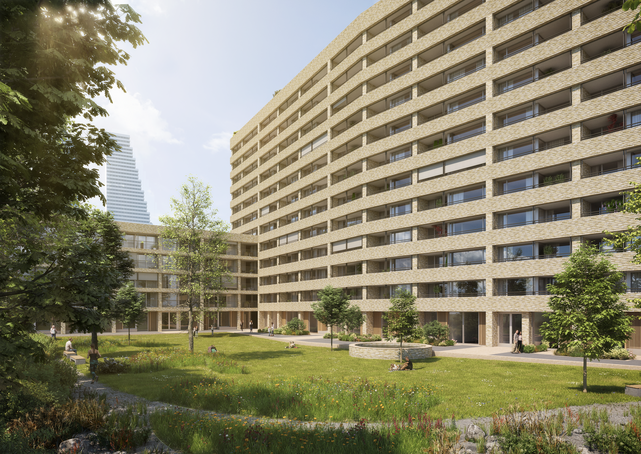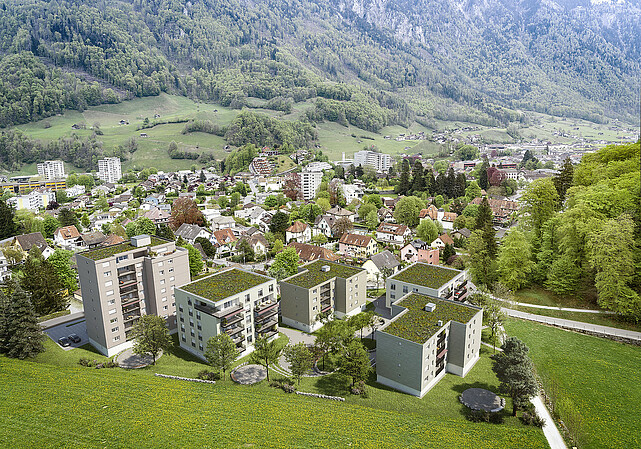Expectations of modern-day living spaces are continuously rising. Not only have the needs of tenants changed, but so have those of investors and society. The following article explains what should be kept in mind for sustainable neighbourhood development, and provides examples of successful implementation.
How does sustainable neighbourhood development work?
A neighbourhood or quarter is a clearly defined residential area that can differ in its location – central or peripheral – and in its size as measured by the number of inhabitants. In the best-case scenario, a neighbourhood should be a lively place with zones where people can meet and linger. The goal is to make better use of meeting zones so that the neighbourhood can come to life and its streetscape be animated in the longer term.
According to the Swiss Federal Office of Energy, sustainable neighbourhood development has eight different components. There are different stakeholder groups when it comes to economic, social and environmental factors. Together, these groups contribute to sustainable development. When creating a sustainable living space, other topics such as biodiversity, slow traffic, energy efficiency, reduction of resource consumption and functional and social integration also play a role. This includes creating inviting public spaces where people can meet and relax.
The consumption and mobility patterns of the modern generations have changed. Various market studies confirm an increase in sustainable lifestyles. People are looking for a living environment where they can follow a lifestyle that pays tribute to environmental as well as economic factors.
Reference project 1: Eisenbahnweg, Basel
The Direct Mandates team, which handles portfolio/asset management for an external client portfolio, is involved in neighbourhood development and sustainability. Two projects that show how these topics can be reconciled.
The first rental apartments in the Eisenbahnweg neighbourhood development in Basel were handed over to the tenants at the end of July 2023. After several years of preparation, planning and execution, the Hirzbrunnen neighbourhood was happy to welcome the new inhabitants. Located close to the Rhine in an attractive urban and central setting, it provides access to all amenities. The green courtyard and Café RhyLäx promote togetherness in the building as well as the neighbourhood and offer new and attractive meeting zones for the tenants and their neighbours. Neighbourhood associations such as the Hirzbrunnen Quartierverein have a long tradition in Basel. It was therefore important to actively involve the neighbourhood association in the process of letting the apartments. This way we could regularly inform the residents about the project in the neighbourhood newspaper "Quart", while also placing advertisements for our rental apartments. During the neighbourhood festival last year we offered guided tours of the building site to interested parties. We would like to integrate the new property with Café RhyLäx, the generous courtyard and roof terrace into future neighbourhood festivals.
The property meets the latest sustainability standards and boasts a powerful photovoltaic system that provides electricity directly to the tenants. The property uses district heating and is equipped with a "smart" control system that can regulate the average flow temperature according to local weather data. Residents also have access to a Mobility vehicle at heavily discounted prices.
By the time the property was ready for the tenants, more than 95% of the apartments had been let.
Reference project 2: Riedernerstrasse, Glarus
The client owns three multi-family houses in Glarus that were built in 1965 and consist of 49 apartments. The year of construction meant that all three properties had to be refurbished completely. Building usage was also reviewed during the preliminary refurbishment examination, and a preliminary project for consolidation with two new buildings was approved. The new construction project also included the refurbishment project, specifically with regard to aligning the physical appearance to the new buildings. The major refurbishment of the old buildings had to be done while the tenants were living there and at the same time as the new construction project in order to share resources and reduce emissions.
Looking to the future, the idea was to upgrade the existing neighbourhood. The groundbreaking ceremony took place in April 2022. The new buildings provided 23 new apartments. All new apartments were rented off plan, which confirms that there is big demand for affordable and attractive living space in Glarus. To upgrade the neighbourhood, the car-free space between the multi-family houses was landscaped with greenery, a playground and areas that invite people to stay and linger awhile. The outside parking spaces and garage boxes were removed and a new shared underground parking garage was built for the car-free neighbourhood.
The Riedernerstrasse neighbourhood development also scored sustainability points. Construction work was primarily done by regional companies. Photovoltaic systems were installed on the roofs of the multi-family houses and the surroundings were designed with biodiversity in mind. The buildings will be connected to the Glarus district heating network in 2024, which will further reduce the carbon footprint.
Summary and outlook
Modern project developments should be viewed in all their complexity. Creating an attractive living space and integrating the neighbourhood and local associations while meeting sustainability standards not only improve lettability, but also bring a better return. Objections and unnecessary delays in construction can be proactively prevented by involving the neighbourhood from the early planning phases.
![[Translate to Englisch:] [Translate to Englisch:]](/assets/group/_processed_/2/8/csm_6034_Riedernstr_Glarus_Aussen_K12_280420_c097c9ea71.jpg)

